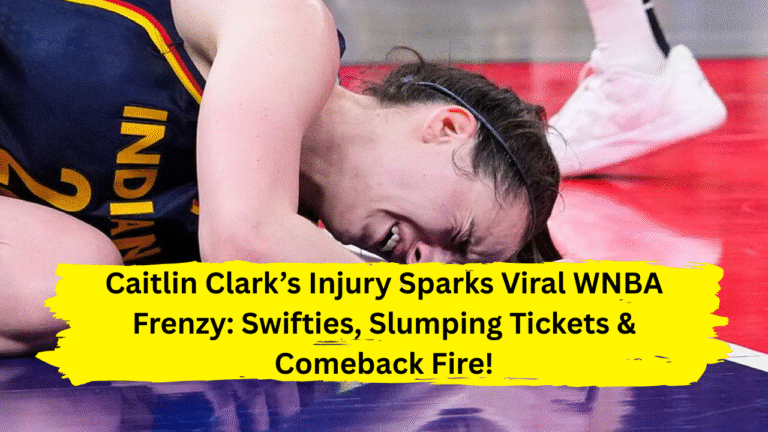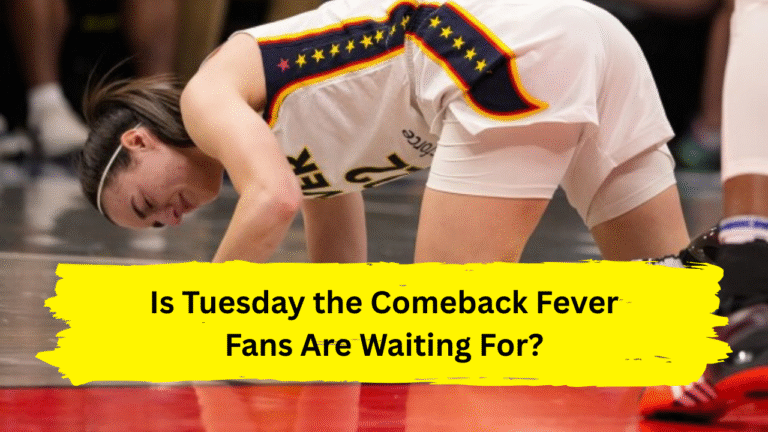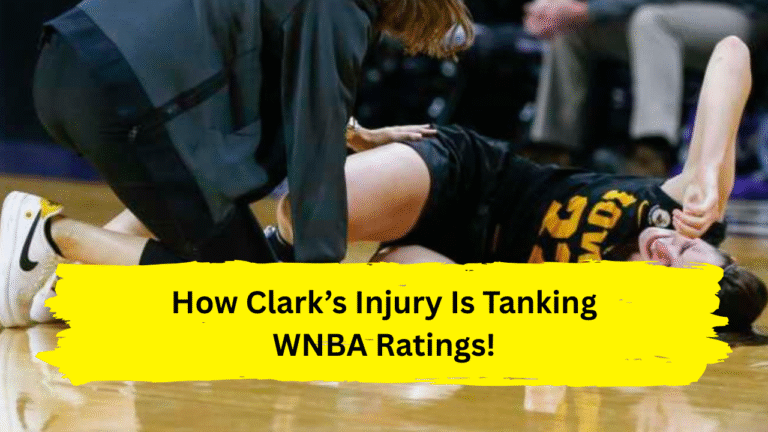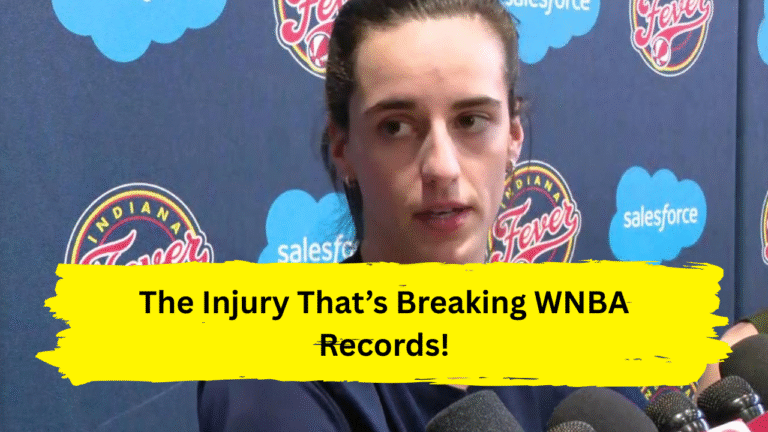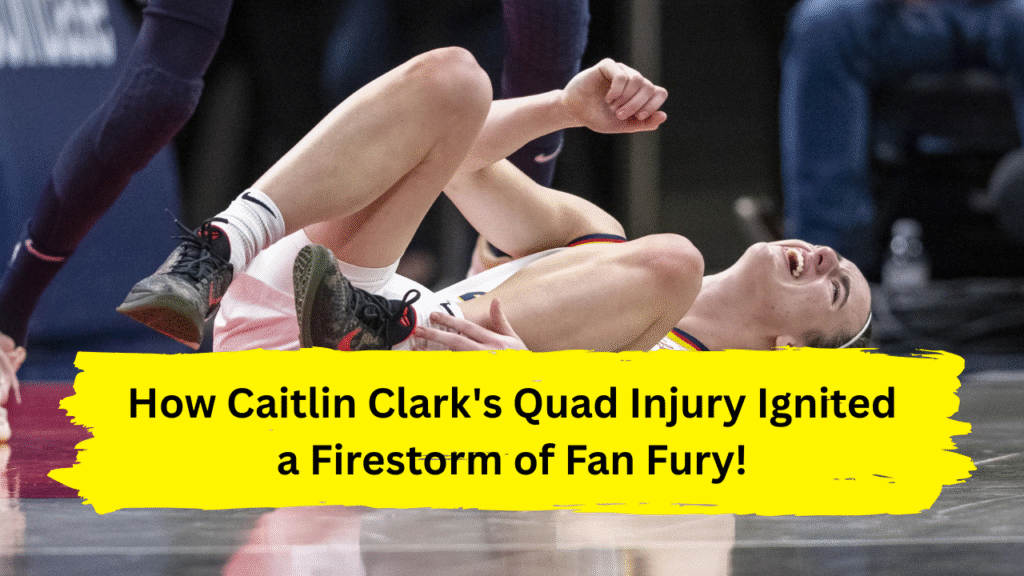
Caitlin Clark’s quad injury sparks MAJOR Fever fan outrage! Dive into the explosive controversy, the team’s response, and what it means for the WNBA’s brightest star. Understand the fury & join the conversation! Read now!
The air crackled with anticipation. Bankers Life Fieldhouse was buzzing, a sea of #22 jerseys waiting for the magic only Caitlin Clark can conjure. Then, the gut punch: Clark ruled OUT with a quad injury. Not just any game, but a crucial matchup. The collective groan turned swiftly into a roar – not of disappointment, but of raw, unadulterated fan outrage. Social media exploded faster than one of Clark’s logo threes. Accusations flew. Trust eroded. The Indiana Fever, already navigating immense pressure with their generational rookie, suddenly found themselves engulfed in a Caitlin Clark quad injury controversy hotter than a summer Indiana asphalt. How did a routine injury report ignite such fury? Buckle up, because this story goes far deeper than a sore muscle.
The Spark That Lit the Tinderbox: More Than Just a DNP
Let’s rewind. Caitlin Clark isn’t just a player; she’s a phenomenon. Her arrival in the WNBA brought unprecedented attention, sold-out arenas, and a tidal wave of new fans to the league and the Fever specifically. Every dribble, every pass, every deep three is an event. So, when she suddenly appeared on the injury report with a quad issue, sidelining her for a key game, the initial reaction was understandable concern. “Get well soon, Caitlin!” flooded timelines.
But the narrative shifted violently, almost instantly. Why? Because this wasn’t happening in a vacuum. Fans, already simmering with frustration over the Fever’s rocky start and perceived mismanagement of their prized asset, saw patterns. They remembered earlier games where Clark looked visibly hampered, grimacing after plays, yet remained on the court. They recalled vague injury reports or downplayed concerns. The Caitlin Clark quad injury announcement felt like the final straw – not just an isolated incident, but evidence of a potentially larger, more alarming trend: Was the franchise prioritizing short-term gains (ticket sales, TV ratings) over the long-term health of their transcendent superstar?
Anatomy of the Outrage: Why Fans Felt Betrayed
This wasn’t just about missing a game. This was about a profound breach of trust. Think about it from the fan’s perspective. You invest emotionally and financially. You buy the jersey, you plan your nights around games, you believe in the future built around this incredible talent. Then, you see your star limping, playing through what looks like pain, while official communications offer little clarity. When the Caitlin Clark quad injury finally forces her out, it feels like confirmation of your worst fears: “They knew. They knew she was hurt, and they played her anyway until it broke.”
The outrage manifested in several powerful ways:
- The “Told You So” Tsunami: Social media became a relentless stream of clips from previous games – Clark clutching her leg, moving stiffly, moments where fans felt the injury was evident but ignored. “SEE?! We SAID she was hurt!” became a deafening chorus.
- Demanding Accountability: Calls for transparency rocketed. Fans wanted detailed explanations: When did the injury really happen? How severe is it? What’s the exact recovery plan? Who made the decisions to play her through visible discomfort? The lack of immediate, satisfying answers poured gasoline on the fire.
- Questioning Competence: The Fever’s medical and coaching staff came under intense scrutiny. Were they properly assessing the injury? Were they communicating effectively with Clark? Were they equipped to manage the unique physical demands placed on a player drawing constant double-teams and physical defense? The Caitlin Clark quad injury became a referendum on the entire organization’s handling of its most valuable asset.
- Fear for the Future: Underlying the anger was palpable fear. Clark is the franchise’s present and future. Fans saw what happened to other young stars pushed too hard, too soon – careers derailed by chronic injuries. The thought of Clark suffering a similar fate, especially under their watch, was terrifying and fueled the protective fury.
The Fever’s Response: Damage Control on a Tightrope
Facing a PR inferno, the Fever organization had to respond. Statements were issued, emphasizing player health as the “top priority.” Coach Christie Sides spoke about communication with Clark and following medical advice. General Manager Lin Dunn likely worked the phones behind the scenes. They walked a precarious tightrope: needing to reassure fans without admitting fault or revealing sensitive medical details that could violate player privacy or tip their hand to opponents.
Did it quell the outrage? Partially, for some. For many others, the statements felt like standard PR fare – necessary but insufficient to rebuild the shattered trust. The true test lies in actions, not words. How transparent will they be about Clark’s recovery? How will they manage her minutes and workload upon her return? Will there be visible changes in how they approach injury reporting and player health management? The shadow of this Caitlin Clark quad injury controversy will loom large over every decision they make concerning her for the foreseeable future. Every wince, every missed practice, every “questionable” tag on the injury report will be dissected with intense suspicion.
Beyond Indianapolis: A League-Wide Moment of Reckoning?
While the epicenter of the outrage is firmly in Indiana, the Caitlin Clark quad injury saga resonates across the entire WNBA. Clark’s impact transcends one team; she’s a league-wide draw and arguably its most marketable star right now. Her health isn’t just an Indiana concern; it’s a league asset.
This incident throws a harsh spotlight on the immense physical toll the WNBA season takes, especially on rookies transitioning from a long college campaign. It raises critical questions about player load management in a compact schedule, the adequacy of sports science and medical resources across all teams, and the pressure franchises feel to capitalize on superstars, sometimes potentially at the expense of longevity. Are protocols robust enough? Are teams truly empowered (or disincentivized) to prioritize rest? The fury of Fever fans is a stark reminder to every front office: mishandle your star’s health, and you risk not just losing games, but losing the faith of your most passionate supporters.
The Unbreakable Bond (and Its Breaking Point): Fans, Stars, and Trust
This whole firestorm highlights the incredibly powerful, yet fragile, relationship between a sports franchise and its fans, especially when a generational talent is involved. Fans don’t just cheer for laundry; they invest in the human beings wearing it. They feel a sense of ownership and protectiveness, particularly towards a player like Clark who embodies hope and excitement. They trust the team to safeguard their investment – both emotionally and in terms of the player’s career.
When that trust is perceived to be broken, as it was with the handling of the Caitlin Clark quad injury, the reaction isn’t just disappointment; it’s visceral betrayal. It feels personal. The outrage isn’t merely about a lost game; it’s about feeling like the stewards of your hope are being reckless with it. It’s the terrifying thought that the future you’re so excited about could be jeopardized by short-sighted decisions. That’s why the anger runs so deep and why simple apologies won’t instantly erase it.
Healing More Than a Quad: The Path Forward for the Fever and Fans
So, where do we go from here? Caitlin Clark’s quad will heal with time and proper rehabilitation – that’s the relatively straightforward part. Healing the rift with an enraged fanbase? That’s a much more complex rehabilitation process.
For the Indiana Fever, it demands radical transparency and demonstrable change. Consistent, clear communication about Clark’s status – even if it’s just “progressing as expected” – is non-negotiable. They need to visibly implement a smarter, more conservative approach to her workload, perhaps even embracing strategic rest days proactively, not reactively. Investing in and showcasing top-tier sports science and recovery resources would send a powerful message. Most importantly, they need to show, through every action, that protecting Clark’s long-term health and career truly is the absolute top priority, above any single game’s outcome or short-term revenue bump. Rebuilding trust requires proving, day after day, that the lessons from this Caitlin Clark quad injury firestorm have been deeply learned.
For the fans, the path involves channeling that fierce passion constructively. Continued pressure for accountability is valid and necessary. However, it must be balanced with allowing the medical process to work and acknowledging that not every detail can or should be public. Supporting Clark means supporting her recovery, which sometimes means accepting she needs time off the court, even if it hurts to watch.
The Final Buzzer: Outrage as a Catalyst for Change?
The Caitlin Clark quad injury controversy was ugly. It was messy. It exposed raw nerves and deep-seated frustrations within the Fever fanbase. But within that outrage lies something powerful: an immense, undeniable love for the game and for a player who has reignited passion for women’s basketball in Indiana and beyond.
This fury shouldn’t just be a footnote; it should be a catalyst. A catalyst for the Fever to operate with unprecedented transparency and caution regarding their superstar’s health. A catalyst for the league to examine load management and player care protocols more rigorously. A catalyst for fans to remain passionately engaged, holding teams accountable while also embracing the necessity of patience for long-term success.
Caitlin Clark’s journey is far from over. Her talent promises years of electrifying moments. The hope now is that the lessons seared into everyone’s consciousness by this Caitlin Clark quad injury uproar ensure she’s on the court, dazzling us, for many, many seasons to come. The Fever’s future, and perhaps a piece of the WNBA’s future too, depends on it. Let’s hope the outrage leads not just to noise, but to meaningful, lasting change. The ball, Fever organization, is firmly in your court.
Also Read: Latest Trending News

